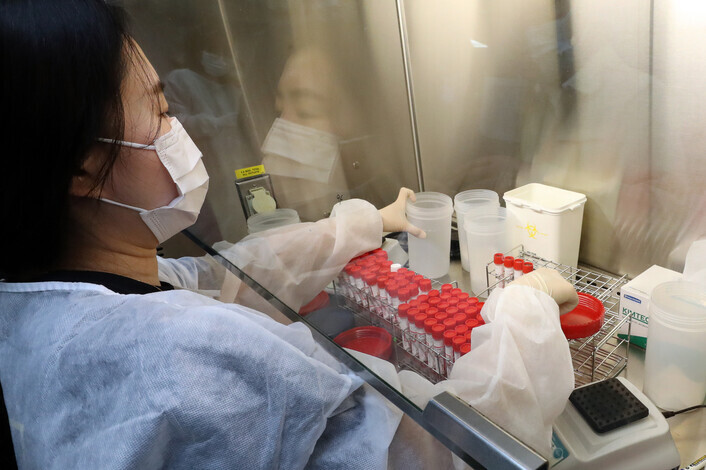hankyoreh
Links to other country sites 다른 나라 사이트 링크
Study finds just 1 plasma sample out of 3,055 contained COVID-19 antibodies

Antibodies capable of neutralizing the COVID-19 virus were found in just one plasma sample among over 3,000 recently collected by disease control authorities. In terms of simple calculations, this represents an antibody prevalence rate of just 0.03%. Disease control authorities therefore concluded that “herd immunity” -- referring to the ability to prevent an infectious disease from spreading without a vaccine due to the widespread presence of antibodies within a community -- is not a viable approach to respond to the pandemic
On July 9, the Korea Centers for Disease Control and Prevention (KCDC) announced findings from an examination of 1,555 primary plasma samples remaining from a 2020 national health and nutrition survey (collected between Apr. 21 and June 19) and 1,500 plasma samples from patients visiting healthcare institutions in southwestern Seoul (May 25-28) for the presence of neutralizing antibodies for COVID-19. The possession of neutralizing antibodies means that a person has contracted an infectious disease, recovered, and gained the immunity to prevent reinfection. Determining the rate of neutralizing antibody prevalence in a population may help to gauge the number of actual infections (individuals with immunity), including hidden cases of patients who had the virus but were never diagnosed.
The study found neutralizing bodies for the coronavirus in none of the national health and nutrition survey samples and in only one of the samples taken in southwest Seoul. On this basis, the antibody prevalence rate was calculated at 0.03% -- a far lower rate than in many other countries. A survey in Spain showed an antibody prevalence rate of 5%. Other rates included 17% for London, 7.3% for Stockholm, and 0.1% for Tokyo. KCDC Deputy Director said South Korea has a lower antibody rate than other countries “because patients have been discovered quickly thanks to the speed and volume of testing, and because the public has been good about observing the use of masks and social distancing.” According to this explanation, the number of hidden patients is likely to not be as large as some had feared thanks to community transmission being more or less checked by proactive disease control efforts.
General view is prevalence rate of 60% or higher is necessary for herd immunityDisease control authorities said that with the antibody prevalence rate found to be less than 1%, herd immunity does not represent a viable response to the virus. The general view among experts is that an antibody prevalence rate of 60% or higher is required for herd immunity to be possible; currently, no country in the world has reached the level of 60%.
“Until vaccine administration has been completed, people will need to observe the rules of everyday disease prevention, such as social distancing and wearing masks,” Kwon advised.
The survey did not include plasma samples from Daejeon, Sejong, or Daegu -- which suffered a large-scale outbreak -- and the sample size was fairly small.
“There are limits to our ability to estimate the scale of COVID-19 virus transmission for South Korea as a whole on this basis,” Kwon said, before adding, “There’s a possibility that there would not be a large difference between the scale of currently confirmed diagnoses and actual infections [even if the sample size were increased].”
Some have voiced skepticism. Kim Woo-joo, a professor of infectious diseases at Korea University Guro Hospital, said, “It’s too soon to reach any interpretations due to the incompleteness of the study, but there is a chance that more hidden patients could be discovered and the antibody prevalence rate could be higher than the current results show if more samples are examined.”
Disease control authorities plan to expand the survey this month to include Daegu and North Gyeongsang Province, with additional testing of national health and nutrition survey samples to be conducted in two-month phases going forward.
By Choi Ha-yan, staff reporter
Please direct comments or questions to [english@hani.co.kr]

Editorial・opinion
![[Editorial] Intensifying US-China rivalry means Seoul must address uncertainty with Beijing sooner than later [Editorial] Intensifying US-China rivalry means Seoul must address uncertainty with Beijing sooner than later](https://flexible.img.hani.co.kr/flexible/normal/500/300/imgdb/original/2024/0517/8117159322045222.jpg) [Editorial] Intensifying US-China rivalry means Seoul must address uncertainty with Beijing sooner than later
[Editorial] Intensifying US-China rivalry means Seoul must address uncertainty with Beijing sooner than later![[Column] When ‘fairness’ means hate and violence [Column] When ‘fairness’ means hate and violence](https://flexible.img.hani.co.kr/flexible/normal/500/300/imgdb/original/2024/0516/7417158465908824.jpg) [Column] When ‘fairness’ means hate and violence
[Column] When ‘fairness’ means hate and violence- [Editorial] Yoon must stop abusing authority to shield himself from investigation
- [Column] US troop withdrawal from Korea could be the Acheson Line all over
- [Column] How to win back readers who’ve turned to YouTube for news
- [Column] Welcome to the president’s pity party
- [Editorial] Korea must respond firmly to Japan’s attempt to usurp Line
- [Editorial] Transfers of prosecutors investigating Korea’s first lady send chilling message
- [Column] Will Seoul’s ties with Moscow really recover on their own?
- [Column] Samsung’s ‘lost decade’ and Lee Jae-yong’s mismatched chopsticks
Most viewed articles
- 1[Editorial] Transfers of prosecutors investigating Korea’s first lady send chilling message
- 2[Column] US troop withdrawal from Korea could be the Acheson Line all over
- 3[Column] When ‘fairness’ means hate and violence
- 4Xi, Putin ‘oppose acts of military intimidation’ against N. Korea by US in joint statement
- 5[Editorial] Intensifying US-China rivalry means Seoul must address uncertainty with Beijing sooner t
- 6[Exclusive] Unearthed memo suggests Gwangju Uprising missing may have been cremated
- 7‘Shot, stabbed, piled on a truck’: Mystery of missing dead at Gwangju Prison
- 8China calls US tariffs ‘madness,’ warns of full-on trade conflict
- 9China, Russia put foot down on US moves in Asia, ratchet up solidarity with N. Korea
- 10Putin’s trip to China comes amid 63% increase in bilateral trade under US-led sanctions